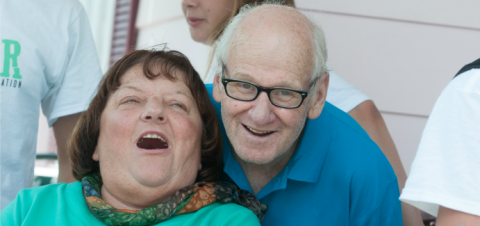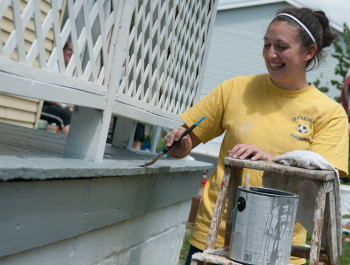Image

Jesse Ergott, President and CEO, NeighborWorks Northeastern Pennsylvania
Challenge: Northeastern Pennsylvania is home to many struggling communities, where high unemployment and low wages are compounded by a rapidly aging population, deteriorating houses and high taxes. Homeowners tend to be stalwart long-term residents, but maintaining their old homes is as challenging as it is essential to their social and economic stability.
Financially strapped cities are battling blight in northeastern Pennsylvania, where residents are either too poor, too old or too sick to maintain their aging homes. Many of their houses are at least 70 years old, according to the most recent census data, which finds 59 percent of Scranton homes were built in 1939 or earlier, 58 percent for Wilkes-Barre and 44 percent for Hazleton, the three cities that make up the largest MSA in the NEPA market. As these homes fall into disrepair, their owners face health and safety hazards, while condemned or abandoned properties invite criminal activity and devalue neighborhoods.
For more than 30 years, the central mission of NeighborWorks Northeastern Pennsylvania (NWNEPA) has been to preserve and improve communities such as these by providing assistance to homeowners in need. But its small staff and limited funding made it clear that NWNEPA would have to get creative. So, in 2010, instead of soliciting funds, the organization reached into the large, untapped pool of local volunteer labor. By forming fruitful partnerships across public and private sectors, NWNEPA developed a reliable force of hard workers ready to serve their neighbors while significantly expanding the organization’s visibility.
Over the next six years, NWNEPA partnered with universities, hospitals, health-care providers and corporations to deploy enthusiastic volunteer armies and contribute almost $1 million in donated labor to repair and beautify hundreds of homes.
NWNEPA first partnered with what is now GroupCares, a leading provider for Christian youth missions, to send volunteers to Carbondale, where hundreds of youths labored alongside adult supervisors to rehabilitate more than 40 homes. The initially tentative relationship between residents and volunteers blossomed over the course of a week. The first day was fraught, with suspicious homeowners peering out their windows at the legions of strangers invading their turf. By the second day, the homeowners had grown more at ease, some even offering home-baked treats. By the third day, homeowners and volunteers were chatting freely and sharing lunch. When the week-long project concluded, the farewells were bittersweet for both sides.
After a similar project in North Scranton, Shirley Russell praised the volunteers who painted her home and worked on her garage and garden. “The work was outstanding,” she said. “It is refreshing knowing that people care, and it helps make you believe in people. I am so proud of my newly painted home.”
 Building on the successful volunteer strategy, NWNEPA formed a partnership with AmeriCorps VISTA for a “Paint The Town” campaign to beautify and repair the homes of senior citizens, people with disabilities and modest-income families in West Scranton.
Building on the successful volunteer strategy, NWNEPA formed a partnership with AmeriCorps VISTA for a “Paint The Town” campaign to beautify and repair the homes of senior citizens, people with disabilities and modest-income families in West Scranton.As these high-impact home-improvement projects proved increasingly successful, NWNEPA next sought help from the all-volunteer Habitat for Humanity, local businesses and community groups in Lackawanna County. The response was quick and enthusiastic, with volunteer teams promised by banks, real-estate associations, churches and colleges. The teams were each assigned to an address and time slot, then provided with on-the-job training and supervision as they set out on their missions.
This model is simple but effective. NWNEPA now has its own locally-based, sustainable home-repair operation but continues to harness the power of volunteers. GroupCares signed on to contribute volunteers through 2016 and moved their troops to West Scranton, another vulnerable area. The efforts again proved hugely successful, attracting attention from the media, funders and government officials.
NWNEPA also launched bus tours of the completed projects for key constituents at the end of each week-long project, and those show-and-tell rides have become instrumental in securing financial and political support for the campaigns.
NWNEPA’s volunteer recruitment, which employs the simplest of outreach techniques, has spawned more than a dozen long-term relationships with large groups. Between 2010 and 2016, 2,500 volunteer teams have completed projects at 276 properties, logged more than 46,600 hours valued at almost $1 million.
These ventures have unveiled a surprising but fundamental lesson: hard labor can be a soft sell. Volunteers now come to NWNEPA unsolicited as word spreads through traditional and social media that they can make a difference that ripples through communities for years. NWNEPA has also learned that camaraderie and team building are key to motivating group efforts. Finally, moving ahead one small step is sometimes necessary to generate momentum. This has played out in several communities; when one house gets a makeover, the neighbors will follow suit -- sometimes even without assistance. In other words: Think big, but don't be afraid to start small.

